IMPROVE MY GAME
Articles
How Powerful Are You Compared to Golfers Your Age?
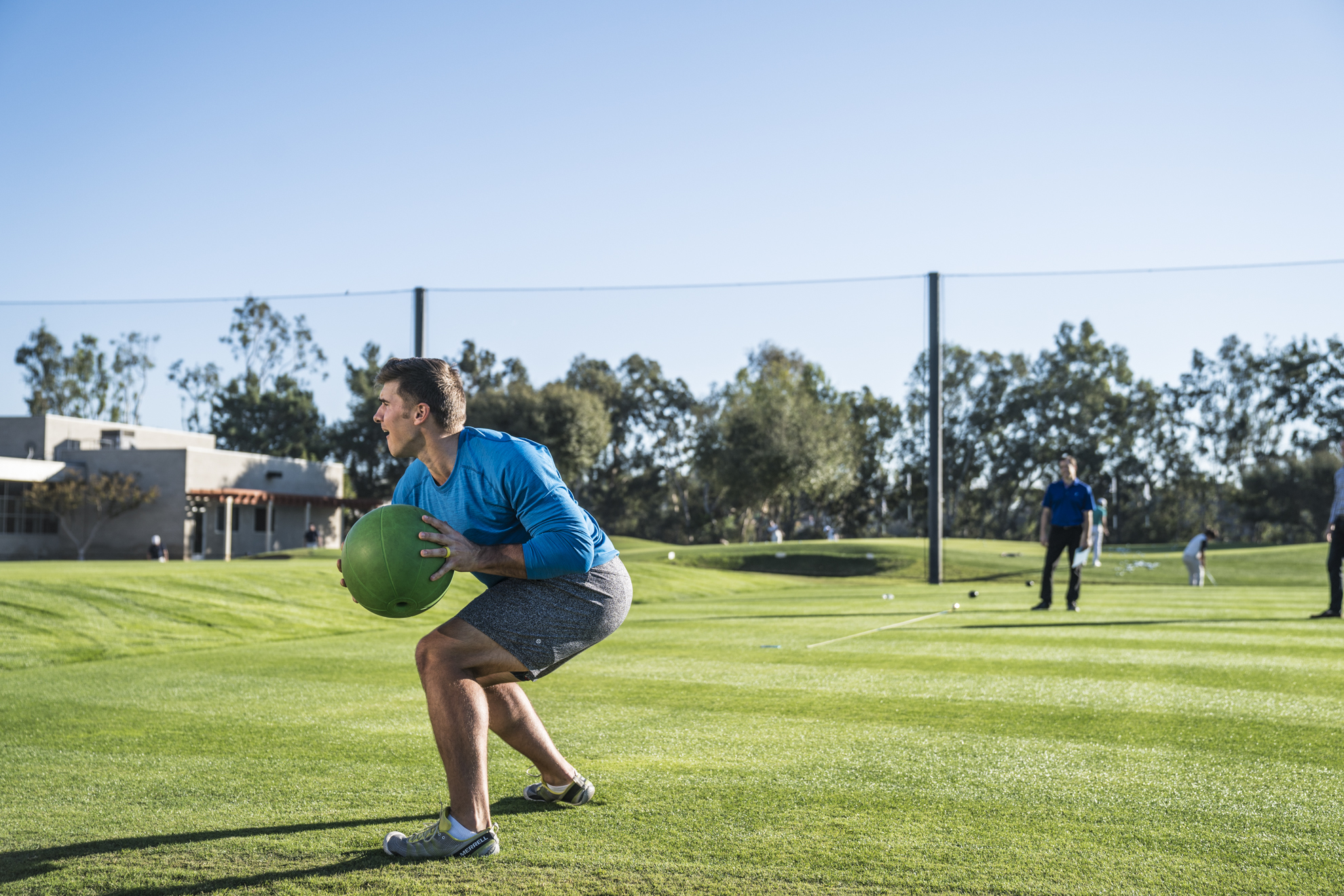
How do you know if you physically can produce enough power to swing as fast as you’d like? What if you are swinging faster than your body is actually able to handle, how would you find that out before you get hurt? These are just some of the questions that many of our golfers have asked me, and they have become the reason behind much of our research and this article.
A few months back, I shared with the TPI community our initial database of club head speeds from just over 600 golfers that had been compiled over the past few years. It has grown to over 700 golfers since then, resulting in an improved ability to break it into smaller age groups and also make more detailed assumptions. If you missed that article, start by reading it here. There were two big comments I heard from the swing speed database article. The first was people wanting to know how fast they swing the club compared to their peers. That is simple, just click on the article above go see where you stand.
The other, which I will focus on for the remainder of this article, was centered around how to increase swing speed. If you remember from my original article, I outlined four quadrants of speed. The goal of this was to simply define the general areas that golfers can gain speed from. As a quick review, the four areas were equipment, technique, mobility and power. If you see that your speed is lower than you’d like, those are the four areas that you can improve in to increase your speed.
Equipment and technique improvements are in the fitting and instructional realms and not my expertise. There are so many other great experts in these areas within the TPI community that I am sure you will be able to find them and improve from their content. Assessing how much mobility and power your have and/or may need, however, is what I do every day with hundreds of golfers every month. So let’s dive in!
Where Does Your Mobility Stand?
That is a logical question to be asking yourself at this point. As TPI teaches, assessing allows us to avoid guessing. To answer the question on mobility, I would recommend finding yourself a great TPI certified professional near you for a full in depth analysis (if you would like to discuss your situation and goals with a fellow TPI Certified professional before you schedule an assessment, I invite you to schedule a complimentary phone consult with us to help you pick the best TPI Professional for you in your area). Now that we have that covered, let’s move on to the fourth quadrant...power!
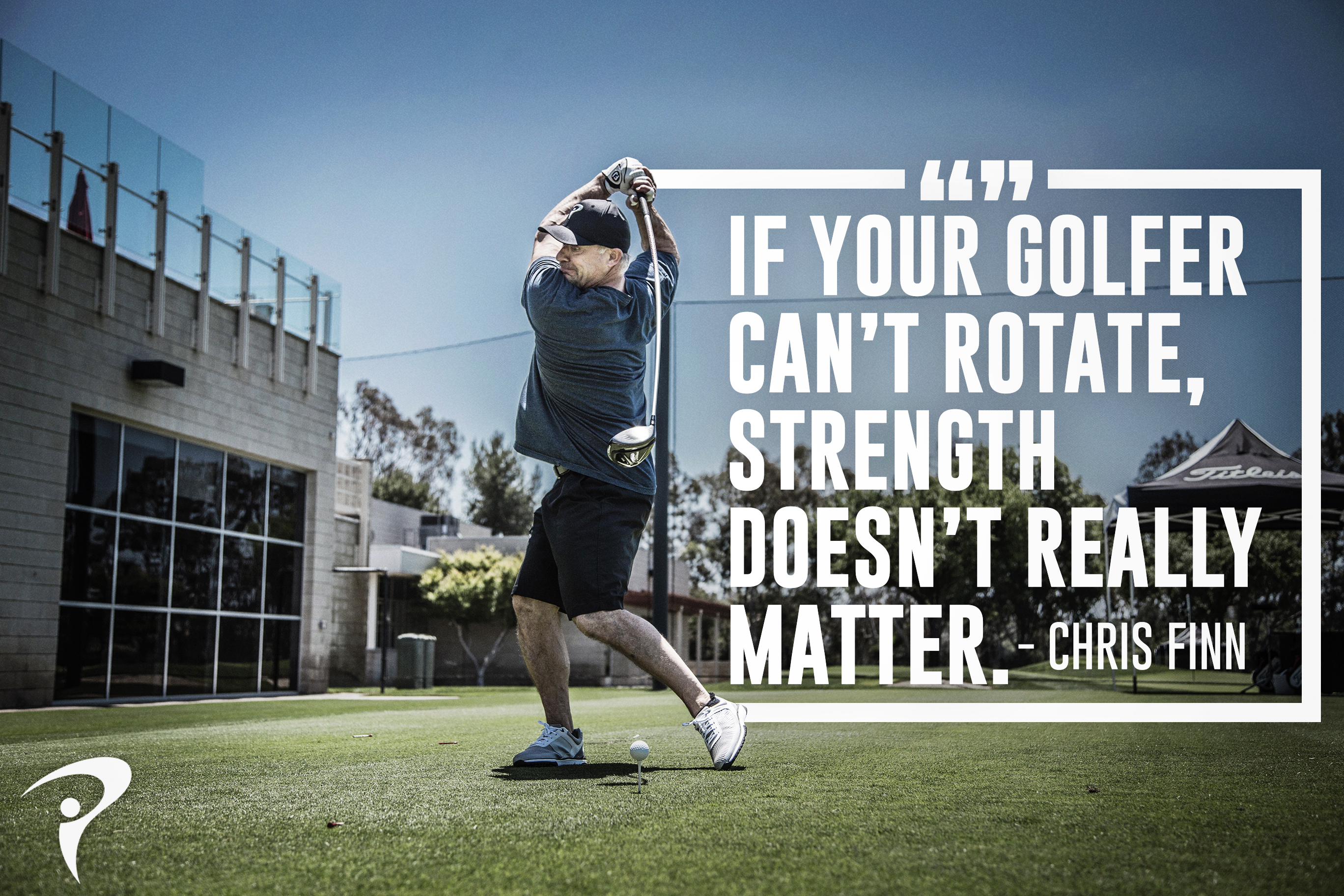
How Powerful Am I Compared to My Peers?
Once you know the answer to your mobility status, the fun one is to figure out is how powerful you are. The power test we use below are part of the curriculum in TPI's advanced Power and Fitness seminars. From our research you can see where your power numbers stack up against other golfers your age around the world. One important takeaway from the data is to understand how much horsepower your body is capable of relative to others your age playing golf. This will give you context as to how fast might be realistic to expect yourself to swing at our current age and even into your 70s. It might be an eye opener that you are really far behind the average golfer your age, or that you are the cream of the crop when it comes to your age group. Either way it is a nice benchmark and good way to know objectively where you stand
More important than comparing yourself to others, however, is understanding how your percentiles in your power tests relate to your club speed. For example, if you swing in the 25th percentile but your power numbers are all in the 75th percentile, you have more horsepower under your hood as is. You likely need to improve technically or figure out something outside of the realm of the physical. Usually in this case (assuming your mobility tests were all cleared and you can rotate well in all four rotary centers), it is a technique or equipment issue. Knowing exactly where to focus your time, attention and finances can save you lots of frustration, strokes and cash!
Case Study: From 106 mph to 125 mph in 12 weeks
One recent example of this that comes to mind is a 29 year old 6’7” golfer of mine. After seeing that his power numbers way outperformed his swing speed percentiles (his vertical was almost 30”) I decided to start digging a little deeper because I suspected he could swing faster right now. I wanted to rule out any physical elements, however, before I sent him to his swing instructor so that I could give his swing coach the best information possible.
The first thing we looked at was his leg dominance. As a left handed player who was right leg dominant as we found, we noted that his lower body did not drive off his lead leg as you would expect for a 6’7” guy with an almost 30” vertical leap. We simply tried a cue to “push down through his right leg” right before impact and his swing speed immediately jumped to 115 mph. This wasn’t magic and isn’t going to add 10 mph to most people’s swing, but in his case, he clearly had an issue of understanding how to use the ground appropriately to express all the power he had.
Armed with this knowledge as well as his evaluation findings, he was able to work on this along with other technical work with a swing coach as well as complete his golf performance strength and conditioning plan. When he returned 3 months later, his swing speed was topping out at 125 mph with better accuracy than he had at 106 mph!
Not bad picking up 20 mph in 12 weeks...scary thing is that his power tests also improved during this time telling me he isn’t near his ceiling yet. This is the power of this research. Even though 125 is about 99th percentile for the 30-39 group (which he will enter shortly) he is an “n” of one and will likely perform above this established norm. It is critical that you evaluate and train every golfer as an individual and this case highlights this point beautifully.
The power tests that we have researched are not done with a golf club, and therefore, your handicap will have no bearing on how you will perform on these tests. While there certainly are correlations between people who perform better on the power tests and those who have higher club speeds (with r-values over 0.7 to be exact), these are just correlations, not causations. And of course, we all know that just because you can hit it 350 yards does not mean you can break par...although it has shown to be important to make a living on the PGA tour.
This is where caution needs to be taken in interpretation of the data. Just because you have high power numbers does not mean you are guaranteed to swing faster and vice versa. You need to contact a local professional who understands how to help you interpret this data and help you put together an efficient plan. Please do not confuse causation with correlation as you read the data. If you have any questions about the data and/or what it means, please do not hesitate to reach out to us.
The Tests
The three tests that we measured to look at their relationship to club speed were standing shot put from both sides (6lb medicine ball), seated chest pass (6lb medicine ball) and vertical jump. The correlations for each test to club speed for the entire sample are below. A correlation of 1.0 means that there is an exact relationship between the two variables, a correlation of 0.0 means there is absolutely no relationship. As you can see, vertical jump had the lowest correlation while shot put right (strong side) had the strongest correlation.
Shot Put R 0.822
Shot Put Left 0.809
Seated Chest Pass 0.802
Vertical Jump 0.644
For a more in depth look at each test’s correlations to the club speed within each specific age group, I would encourage you to download the entire free report here.
Below are the charts for the power tests and their percentiles for each age group.
* NOTE: Because the sample size for women ages 30- 39 and 40 - 49 are so small, the corresponding values are only reported for men.
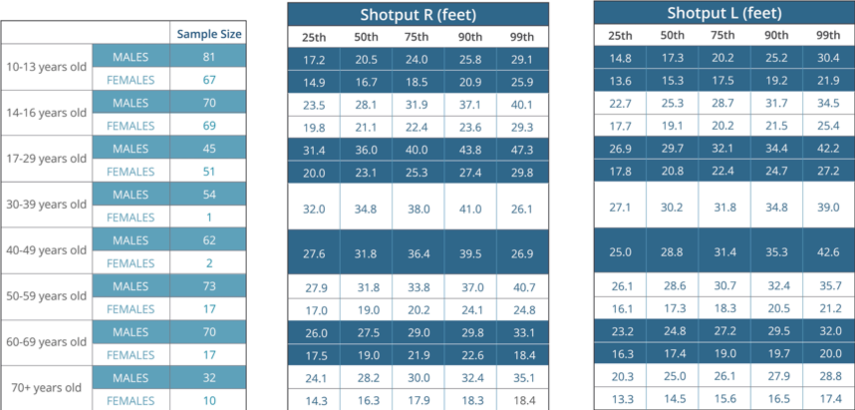
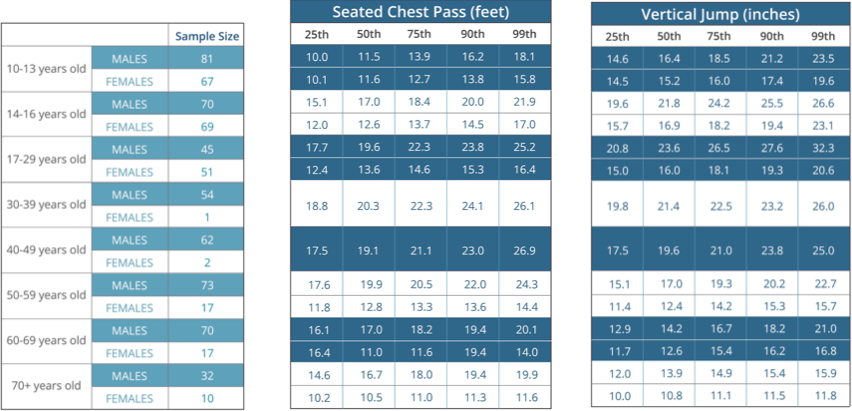
Shot Put Right and Left (complete this test from both sides
Do not let the athlete step over in front of their lead foot, they must stay planted on the lead leg. Measure from where the ball lands to the athlete’s lead hip.
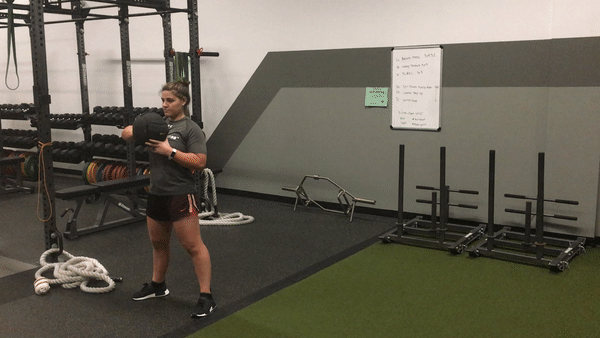
Seated Chest Pass
Feet must be flat on the ground and back must stay in contact with the chair. Measure from where the ball lands to the athlete’s chest.
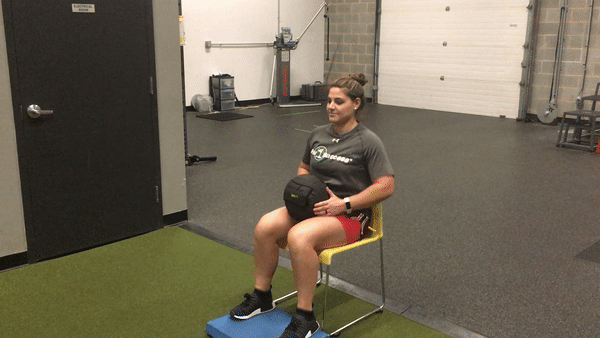
Vertical Jump
If you don’t have technology to measure you, the “sticky note” vertical leap test is a simple at home way to get an estimate of your leap.
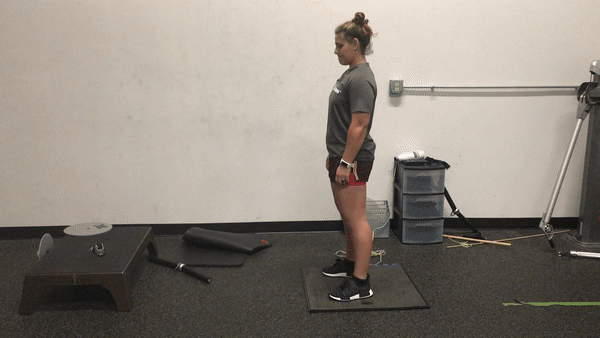
What Does This All Mean
As you can see from the tables, there are extremely high levels of correlation to club speed with these tests. If you perform well in these tests you are likely to perform well in club speed relative to your peers. In my opinion, however, the more valuable piece of this data is being able to understand for the first time how your power numbers match up or don’t match up to your swing speed numbers.
As a professional working with golfers of all ages and abilities, being able to understand what all the data means relative to each other for the individual in front of me is priceless. The question of where to improve power can be more clearly answered now than ever before. It is also able to be done in a simpler fashion that is doable just about anywhere in the world with minimal equipment or technology. Our hope is that this makes the ability for golfers to assess themselves much easier.
The area of focus in a training program to improve power should be sure to focus on the areas of deficit noted from the testing. For example, if a player has very good vertical leap and seated chest pass but their shot put tests are 50 percentile points lower, a program focusing on rotational sequencing, strength and coordination would likely be of huge benefit. The player in this case is clearly able to create sufficient vertical and upper body force, but their ability to sequence and coordinate the two of those into a rotational specific pattern is clearly limited.
In another case, if a player’s vertical leap is incredibly low relative to their other metrics (as often is seen post total joint replacement or other lower extremity interventions), an in depth strength assessment is likely necessary to determine if it is a strength issue or a speed issue. It is very common that there has been a loss of force production capability post operatively that is negatively impacting the golfer’s ability to produce significant vertical force in a meaningful way for swing speed.
Considerations for the Future
Looking ahead to future research and an improved ability to interpret data, I believe it is going to be extremely important to determine the most important relative strength and relative power metrics in addition to these absolute metrics. While these absolute metrics clearly have strong correlations to club speed, the changes in their r-values from age group to age group suggests that there are more individualized and meaningful metrics that could be looked at to tell you more of the story. This is where much of our current and future research is headed.
At this point, however, we feel as though golfers and professionals in the instructional, medical and fitness worlds should be able to get a very clear picture of where their golfer is to determine the best plan forward for them. As we continue to grow our database, further our understanding of relative metrics and establish normative values within them, we will be able to give even more specific answers to “how strong is strong enough”, “how fast is too fast for your strength levels,” “what puts you at risk for injury,” and much more.
As our industry continues to evolve and develop, it will continue to be critical to use objective measures that allow regular amateur golfers to compare themselves to others like themselves, not PGA and LPGA Tour Professionals. Within PGA and LPGA Professionals, we believe Champions Tour players, (L)PGA Tour Players in their 30s and 40’s and (L)PGA Tour Players in their 20’s should not be comparing themselves to each other for what is “normal.” They are at different points in their athletic and professional careers and training them all the same will lead to poor results.
At Par4Success we are committed to our mission of helping golfers play better, swing faster and hurt less for as many years as they can. We believe that practical and meaningful research is one of the best ways to facilitate this so that professionals can continue to meet golfers where they are in life and golf to help them reach their goals. We look forward to sharing more research findings as they become available.
If you have questions about your numbers, where you stand and/or what to do about them, please do not hesitate to contact us for a complimentary discussion of your situation, goals and best path forward. Visit www.par4success.com to connect with us!

Chris Finn is a Licensed Physical Therapist, Certified Strength and Conditioning Specialist, Titleist Performance Institute Certified Medical Professional, Certified Precision Nutrition Coach, and trained to perform Trigger Point Dry Needling in North Carolina. Since starting Par4Success in 2012, Chris has and continues to work with Touring Professionals, elite level juniors & amateurs as well as weekend warriors. He has contributed to numerous media outlets including GolfWRX, is a published author, works with many of the nation’s leading coaches and instructors to improve their players and presents all over the country on topics such as Golf Performance, Junior Golf Athletic Development, Injury Prevention and Power/Speed improvement for golfers.